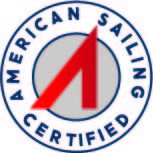
ASA 102, Keelboat 2

Able to skipper and crew aboard a sloop-rigged keelboat of approximately 20 to 30 feet in length by day in winds up to 20 knots. Depart, sail, and return with control demonstrating teamwork.
| Prerequisites | and the ability to demonstrate competencies in all knowledge and skills elements of that Standard. ASA 101 or equivalent sailing skills & experience. |
|---|
KNOWLEDGE
Terminology
1. Define and describe the function of the following terminology and sail parts:
Standing Rigging
- Backstay
- Forestay
- Shroud
- Mast
- Boom
- Spreader
Running Rigging
- Boom vang
- Main sheet
- Jib sheet
- Traveler
- Jib lead
- Main halyard
- Jib halyard
- Outhaul
- Downhaul/cunningham
Sails
- Mainsail
- Jib / Genoa
- Batten & Batten Pocket
- Head/ Tack/ Clew
- Luff/ Leech/ Foot
- Bolt rope / Luff Slide
Other Parts
- Cleat
- Gooseneck
- Roller furler
- Shackle
- Telltales (luff, leech, in rigging)
- Tiller
- Wheel
- Winch & Winch handle
Crew Roles
- Jib trimmer
- Mainsail trimmer
- Helmsperson
Wind & Trim Concepts
- True wind
- Apparent wind
- Lift
- Flow
- Stall
- Airfoil
- Weather helm
- Chord length
- Angle of Attack
- Depth (camber or draft)
- Draft position
- Twist












